Aritz Lekuona: "The problem of purine comes with the industrialization of livestock"
So far you have worked in pilot plants. What results have you obtained?
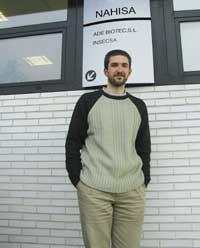
Good. We had pilot plants on a pig farm in Toledo and on a cattle farm in Igeldo. In them we have shown that this technology is viable. Gradually, with changes we have optimized the process and the design of the commercial installation is already defined. We are now in a position to market industrial purine treatment plants. The first will be Errenteria and then Igeldo. In fact, in the hamlet of Igeldo, where we had a pilot plant, we are also thinking of installing an industrial plant. In each farmhouse we will make a small installation.
Purine treatment plants that have been proposed so far are large, with the aim of purifying the purine of the entire region. But we believe that local treatment in small treatment plants is much more sustainable.
What is the goal of the treatment you have developed?
Solving the environmental problems of a large farm. This is because, due to purine, farms with high numbers of livestock produce environmental damage. The accumulation of waste or slurry is a problem due to water pollution, among others.
Why is it so harmful to the environment?
Until now in the hamlets straw was put under the animals. It absorbed animal droppings and urine straw or ferns, thus forming manure. However, today, large farms do not rise and all waste is mixed, in liquid form, forming purines. The problem of purine has come with the industrialization of livestock, with an intensive model.
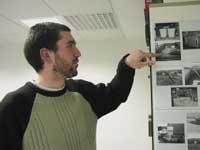
To date it has been used to fertilize soils near the manure. However, there are currently large farms with large numbers of livestock heads that contain very high amounts of waste and do not have enough soils to assimilate all these waste in their environment. In these cases, higher amounts are extended than those that can absorb the surrounding soils, thus polluting the surrounding waters, odours are released, etc.
The technology you have developed is based on electroflotation. How does the idea of purifying purine by electroflotation arise?
The idea arose in Inasmet because the electroflotation had already been used to purify other wastewater such as drills, metallurgical, always with wastewater of difficult purification.
The idea was tested at the laboratory level in 2001. The results showed their viability and that was when the ADE Biotec emerged.
We are ascending and lowering the electroflotation. What is electroflotation?
It is an electrochemical technology. The slurry is passed between several iron plates to which a low voltage electrical current is applied. This causes the iron of the plate to dissolve inside the purine in the form of Faith 2 +. Fe 2 + acts as a coagulant, coagulating and easily separating from water the organic substances present in the purine and the rest of nutrients, mainly in colloidal state.
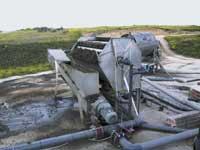
On the other hand, small hydrogen bubbles are also formed that help bring coagulated organic matter to the water. Two easily separable phases are thus obtained.
Usually puff is inserted into the reactor and at the exit comes a kind of foam from the top – organic matter and nutrients – and from the bottom comes purified water or clean water.
Therefore, the products resulting from this process are a kind of foam and water. What is done with them?
Dehydrate and solidify the upper foam. This solid has the same properties as manure, but in a much smaller volume. For example, if we have one hundred cubic meters of purines before purifying, in the end we only have five solid cubic meters.
Sometimes this manure is sold, but it is usually picked up by a farmer in the area who needs manure or peat. Often the farmer himself uses it to fertilize his land.
The liquid obtained by purification of purines can be used for irrigation or to clean the farm itself, since it is mainly water. But it can also be achieved that the discharge rules to the collector or river are met, for which only a simple biological treatment can be performed.
What are the advantages of electroflotation compared to other purine purification technologies?
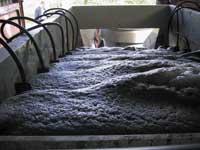
Technologies are compared according to the cost of operation or treatment, a cubic meter of purine treatment cost. In many cases, during the process, a lot of energy and reagents are consumed, which affects the price of the liter of milk or the kilo of meat. And that is a loss of profit from the farmer.
The cost of electroflotation is very low compared to conventional methods used to date. For example, in the case of beef farms, the cost of our installation is two euros per cubic meter of purine. On the contrary, the most chemical or biological treatment is usually three or four euros.
What is done with purine on farms in Euskal Herria?
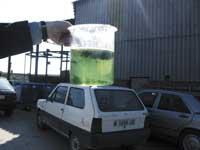
So far it has spread over nearby land, usually without excessive controls. The existing legislation is quite superficial. However, in the future the measures will be sharpened by European pressure. France, Holland and Germany already have strict laws. And in France, for example, ranchers are required to install purine scrubbers when they cannot prove they have enough land nearby.
Ranchers are not legally required to purify the purine. On all farms there will be more obstacles to installing scrubbers.
The main obstacle is that livestock is a low-profit sector. Despite the abundance of livestock, without public subsidies it is difficult to face such an investment. The existing barriers are fundamentally economic.
Purine is said to pollute a hundred times more than urban waters. Among other things, when it degrades, methane is produced, one of the greenhouse gases.
But methane is not the only gas that gives to purine, but also contains benzenes and sulphated gases, among others. They are the ones that produce the bad smell.
In fact, pork pudding is a very good manure. Its composition is influenced by factors such as swine race, age and health status of animals, type of fodder, etc. However, purine has an average of 55-65% organic matter.
Farms have used pig pudding to fertilize the surrounding soil. However, large nurseries do not usually have large areas of land in their environment, and when they expand the pile of manure they generate, the land receives too many nutrients, especially nitrogen, phosphorus and potassium, and dissolved in rainwater, contaminating groundwater.
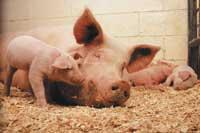
It also affects surface waters. In fact, when the nitrogen from pig pudding reaches rivers, lakes or lagoons, vegetation grows more than normal, rots and water causes the loss of oxygen. Consequently, the species of this environment disappear and the ecosystem is greatly impoverished. This phenomenon is known as eutrophication.
In France, among other things, eutrophication is a fairly widespread phenomenon, known as green tide.
However, France is not the only country concerned with purine. The damage caused by pig manure in the European environment is not the midnight cough of the goat.
In the Netherlands, for example, the number of pigs that breed has already been limited, so a more responsible production is wanted, although the kilo of pork is much higher.
Spain is, together with Germany, the country that grows the most pigs in Europe. They grow more than 21 million. Each pig generates about two cubic meters of purines a year, which is a serious problem. However, it does not seem that they limit production for the moment, although in the sixteen existing treatment plants only one fifth of the purine will be purified.
The traditional way of purifying the pudding is composting, that is, turning it into manure. Of course, this method is nothing expensive. However, in the large nurseries there is an excess of pudding to take advantage only of the traditional method. Therefore, purine purification facilities are necessary. The main barrier of these industrial treatments is the economic one, since the sector still does not have access to environmentally acceptable and economically viable treatment technologies, despite the progress being made. Large purine treatment plants are currently being built to meet the needs of adjacent farms. The most widely used technology in these treatment plants is anaerobic digestion. Purine is kept free of oxygen for bacteria to ferment organic substances, obtaining manure and as a side product biogas. By cogeneration, this biogas produces electric energy and the heat produced is used to accelerate fermentation. |
Buletina
Bidali zure helbide elektronikoa eta jaso asteroko buletina zure sarrera-ontzian











